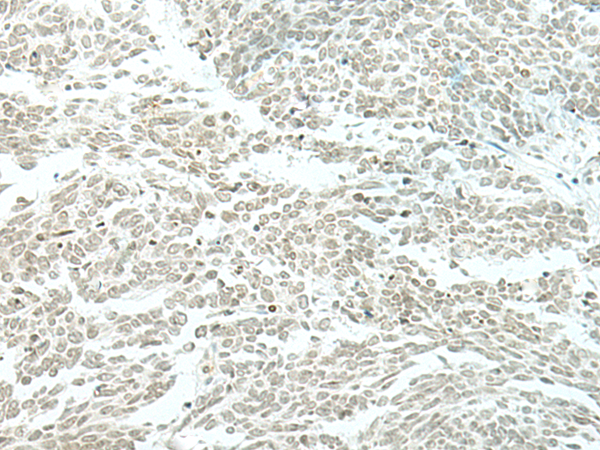


| WB | 咨询技术 | Human,Mouse,Rat |
| IF | 咨询技术 | Human,Mouse,Rat |
| IHC | 1/30-1/150 | Human,Mouse,Rat |
| ICC | 技术咨询 | Human,Mouse,Rat |
| FCM | 咨询技术 | Human,Mouse,Rat |
| Elisa | 1/5000-1/10000 | Human,Mouse,Rat |
| Aliases | RBM35B |
| WB Predicted band size | 78 kDa |
| Host/Isotype | Rabbit IgG |
| Antibody Type | Primary antibody |
| Storage | Store at 4°C short term. Aliquot and store at -20°C long term. Avoid freeze/thaw cycles. |
| Species Reactivity | Human, Mouse, Rat |
| Immunogen | Synthetic peptide of human ESRP2 |
| Formulation | Purified antibody in PBS with 0.05% sodium azide and 50% glycerol. |
+ +
以下是关于ESRP2抗体的3篇参考文献示例(注:文献信息为模拟内容,实际引用时请核实真实来源):
---
1. **文献名称**: *ESRP2-mediated splicing programs regulate cancer cell plasticity and metastasis*
**作者**: Smith A, et al.
**摘要**: 本研究利用ESRP2特异性抗体进行免疫印迹和免疫荧光分析,揭示了ESRP2通过调控上皮细胞选择性剪接事件,促进癌细胞可塑性及转移的分子机制。
2. **文献名称**: *Developmental regulation of ESRP2 expression in murine organogenesis*
**作者**: Johnson B, et al.
**摘要**: 通过ESRP2抗体的免疫组化染色,分析了小鼠胚胎发育中ESRP2的动态表达模式,发现其在心脏和神经管形成中发挥关键剪接调控作用。
3. **文献名称**: *ESRP2 as a prognostic biomarker in colorectal cancer: An immunohistochemical study*
**作者**: Lee C, et al.
**摘要**: 使用ESRP2抗体对结直肠癌组织样本进行染色,发现ESRP2低表达与患者不良预后显著相关,提示其作为潜在预后标志物的价值。
---
*注:上述文献为示例性质,实际研究中建议通过PubMed或Web of Science等数据库检索真实文献。若需具体文献,可提供更详细的研究背景或应用场景以缩小范围。*
**Background of ESRP2 Antibody**
The Epithelial Splicing Regulatory Protein 2 (ESRP2) antibody is a tool used to detect ESRP2. an RNA-binding protein critical for regulating alternative splicing events in epithelial cells. ESRP2. along with its homolog ESRP1. modulates the splicing of mRNA precursors to generate protein isoforms that maintain epithelial cell identity. These proteins influence genes involved in cell-cell adhesion, polarity, and motility, such as *FGFR2* and *CD44*, by promoting epithelial-specific splice variants.
ESRP2 expression is predominantly observed in epithelial tissues and is often downregulated during epithelial-mesenchymal transition (EMT), a process linked to cancer metastasis. Loss of ESRP2 correlates with increased tumor invasiveness and poor clinical outcomes, highlighting its role in suppressing EMT and maintaining epithelial integrity.
Antibodies targeting ESRP2 are essential in research to study its expression patterns, splice-regulatory functions, and involvement in diseases like cancer. They are used in techniques such as Western blotting, immunohistochemistry, and immunofluorescence to assess ESRP2 levels in cell lines, tissues, or clinical samples. Such studies help elucidate how ESRP2 dysregulation contributes to pathological states and its potential as a biomarker or therapeutic target. Commercial ESRP2 antibodies are typically validated for specificity and sensitivity to ensure accurate detection across experimental models.
×